What People Are Asking
Did Our Lady Use the Term Masonry
in Her Prophecies?
Dr. Horvat responds:
Dear C.K.,
Thank you for your e-mail, and I am pleased to see that you are taking seriously the prophecies of Our Lady of Good Success. I am glad to answer your questions, and will do it in the same order you made them:
1. The name of Freemasonry only became public in 1717 when four lodges in London formed the first Grand Lodge of England; thenceforth that organization experienced a rapid expansion on the Continent and in the Americas. However, those who know the history of Freemasonry affirm that its roots are much deeper and travel much further back than the 18th century.
A. A secret and a semi-public Freemasonry
To confirm this affirmation let me transcribe a text by Msgr. Henri Delassus, the best scholar I know on the topic:

Our Lady foresaw the evils of Masonry
“It is difficult to conceive that this civilization, combated all this time by the Church, could subsist and develop through five centuries, and then finally emerge with the power we see it has today unless we suppose that, during all this time, there were men who transmitted from generation to generation how to guard and disseminate it and that a powerful association existed to prepare its triumph.
“A true conspiracy against Christianity supposes, in effect, not only the vow to destroy it, but also a group of persons and an agreement on the means to attack, combat and annihilate it.
“Since these adepts conspire against the existing state of affairs, they have every interest in hiding themselves while they live and in not leaving behind any possible trace of the existence of their association and plot.
“Serious signs, however, allow us to believe that the ideas of the Humanists were taken up by Freemasonry. Independent of whether it existed or not before the Humanists, in the 18th century Freemasonry attempted to realize its plans, and in our days it is taking advantage of the former’s experience and lack of success.
“The Freemasons pretend that their origin goes back to Solomon’s Temple, and also that they are the heirs of the mysteries of Paganism. It is not our point to examine here the basis or lack of such for these pretensions. Rather, we will look at whether, in modern times, the sect was in fact the soul of the social transformation that started in the Renaissance, went forward in the Reformation, was achieved in the [French] Revolution, and has continued to spread the same ideas for more than one century.” (La Conjuration Anti-chrétienne, Lille: Desclée de Brouwer, 1910, vol. I, pp. 104-105)
We see, therefore, that Freemasonry most probably existed as an unknown secret society for many centuries before the 18th century. So, in principle, Our Lady could have mentioned it either generically or specifically in her revelations in the 17th century.
B. Possible insertion of the word Freemasonry in the revelations
We cannot exclude, however, the possibility that Fr. Pereira, who wrote his work in the late 18th century and knew about the public role of the Freemasonry against the Catholic Church, could have interpreted Our Lady’s mention of the enemies of the Church as referring to Freemasonry and used this word, even if it was not used by her.
This hypothesis does not imply that he intended to adulterate the text, but rather that he meant to confirm what had become apparent in his times. If he did so, it was because he was certain that the veracity of the original texts could be checked in the many primary documents on the revelations that existed in the Convent archives when he wrote his work. He could not know that all those works would disappear, and that only his would remain as a source for the revelations.
At any rate, let me go on to show what he actually wrote.
C. What Fr. Pereira wrote on Freemasonry
The Portuguese Franciscan Fr. Manuel Sousa Pereira, who traveled to Quito in 1777 and wrote The Admirable Life of Mother Mariana in 1790, was keenly aware of Freemasonry and its anti-Catholic and anti-monarchic purposes. In the Spanish edition of his biography of Mother Mariana that we have, at times he uses the word diabolical sect or sect, and other times Masonic sect when he records the prophecies of Our Lady to Mother Mariana.
There are six such references:
The first one is in the fourth apparition of January 21, 1610. In it, Our Lady told Mother Mariana: “Thus I make it known to you that from the end of the 19th century and from shortly after the middle of the 20th century, in what is today the Colony and will then be the Republic of Ecuador, the passions will erupt and there will be a total corruption of customs, for Satan will reign almost completely by means of the Masonic sects. They will focus principally on the children in order to sustain this general corruption. Woe to the children of these times!” (Vol. II, p. 21)
The Spanish reads: “... Se levantarán las pasiones y habrá una total corrupción de costumbres por las que Satanás reinará en las sectas masónicas y dañará principalmente a la infancia, a fin de mantener con esto la corrupción general. ...” (Tomo II, p. 12) (1)
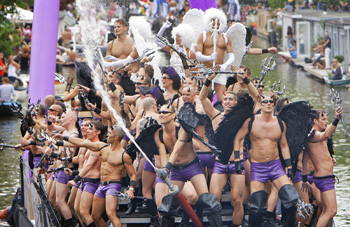
Our Lady predicted public immorality and a total corruption of customs. Above, a 'gay' pride canal parade in Amsterdam; below, fans of the vampire Twilight cult
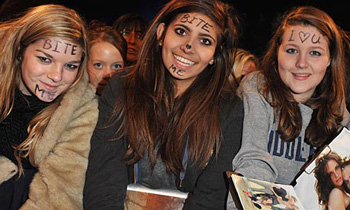
The Spanish reads: “... [El Sacramento del Matrimonio] será atacado y profanado en toda la extension de la palabra. El Masonismo, que entonces reinará, impondrá leyes inicuas con el objeto de extinguir ese Sacramento. ...(Vol II, p. 14)
The third reference is in the apparition of February 2, 1610, when Our Lady speaks about the 20th century: “During that epoch the Church will find herself attacked by terrible hordes of the Masonic sect, and this poor Ecuadorian land will be agonizing because of the corruption of customs, unbridled luxury, the impious press, and secular education.” (Vol. II, p. 39)
The Spanish reads: “En aquella época la Iglesia se encontrará combatida por las hordas de la secta masónica. ...” (Vol. II, p. 34)
The fourth reference is a summary in Fr. Pereira’s words of an apparition of Our Lady to Mother Mariana about the Feast of Corpus Christi. Fr. Pereira relates: “These countrymen would work to oppress the Church in their assemblies and prevent this public devotion [Corpus Christi processions], for they would have already entered the party of Satan by becoming members of the [Masonic] lodges. … He showed her how the hideous and pestiferous wild boar of masonry would enter the beautiful, flourishing vineyard of the Church, leaving it destroyed and in complete ruin.” (Vol. II, p. 109)
The Spanish reads “... Por haberse pasado y al bando de Satanás, inscribiéndose en las loggias. … Y se mostró la viña de la Iglesia florida y Hermosa, en la cual entrando el jabali pestífero y horrible de la masonería, la dejaría arrasada y en complete ruina.” (Vol. II, p. 120)
The fifth reference in the apparition of February 2, 1634, speaks only of a sect, Our Lady told Mother Mariana that the fourth motive for the Tabernacle light going out “is that the [Masonic] sect, having infiltrated all the social classes, will be so subtle as to introduce itself into domestic ambiences in order to corrupt the children, and the Devil will glory in dining upon the exquisite delicacy of the hearts of children.” (Vol. III, p. 30)
The Spanish reads, “El cuarto motive de apagarse la lamparita es que habiéndose apoderado la secta de todas las clases socials, tendrá sutileza para introducirse en los hogares domésticos....” (Vol. II, p. 212)
The sixth reference speaks of diabolical sects, when Our Lady talks about Ecuador at the beginning of the 20th century: “Ecuador will see itself oppressed, enslaved and persecuted by diabolical sects. This sectarianism will last for 30-33 years.” (Vol. II, p. 235) In passing, I note that the Rule of the Liberals lasted 30 years, from 1895 to 1925. During this period the Church was virulently persecuted by the partisans of Freemasonry.
The Spanish reads, “... Perseguida por el sectarismo diabólico…” (Vol. III, p. 60).
Conclusion
It seems to me there are three possible answers regarding the reference to Freemasonry in the copied manuscript we have of Fr. Manuel Sousa Pereira.
First, the term Masonry was not in the original sources used by Fr. Pereira, that is, in the Autobiography of Mother Mariana and other biographies and source documents that were preserved in the Cuadernon and are presently lost. Being familiar with Masonry and its persecution of the Church, Fr. Pereira used the actual term diabolical sect and Masonry interchangeably. In this case, the word would be Fr. Pereira’s addition to the prophecies.
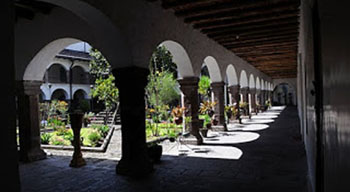
The documents are hidden somewhere inside the walls of the Convent; below, the convent (center) in the Plaza
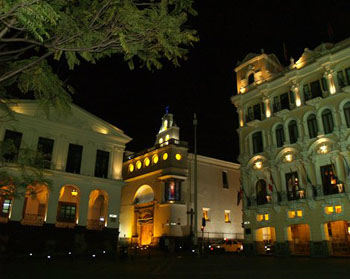
Third, the term was the one used in the original manuscript of Fr. Pereira, who would have faithfully recorded the words of Mother Mariana in relating the prophecies of Our Lady of Good Success in the mid-17th century texts.
The third supposition seems the most probable to me since it does not appear likely that Fr. Pereira, a serious priest who wants to provide the most accurate details of the apparitions possible, would take liberties with the prophecies he found in the archives. Nor would it be impossible or absurd for Our Lady to speak of a coming danger, using a precise term unknown at the time.
She made a similar prophecy in Fatima. In the apparition of July 13, 1917, Our Lady told the three children that the “great war” would begin during the reign of Pius XI. Since Pope Pius XI did not ascend to the papacy until 1922, Our Lady correctly foretold not only the coming World War, but also the name of the future Pope. As Queen of Heaven and earth, it is certainly within her power to know the contingent future.
In short, until the other original documents generally referred to as the Cuadernon are found, nothing can be asserted with certainty about the use of the term Masonry. When it is found - as it will be, according to another prophecy of Mother Mariana - we will have not only the original manuscript of Fr. Pereira, but the earliest biographies of Mother Mariana written shortly after her death and her own autobiography. Then, everything will be clear.
Response to other questions
2 & 3. Your second and third questions were answered elsewhere on the TIA website. You may read the response here.
4. You may address the possibility of translating the material we have on our website to French with our editor, Mr. Atila Guimarães. You may contact him here.
I hope these answers will be of some assistance to you.
Cordially,
Marian T. Horvat
- "The English excerpts are from The Admirable Life of Mother Mariana Vol. I and vol. II, (Los Angeles: TIA, 2006); The Spanish excerpts are from Vida admirable de la Madre Mariana de Jesús Torres y Berriochoa (Quito: Fundación Jesús de la Misericordia).

Posted January 10, 2013
______________________
______________________













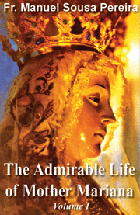

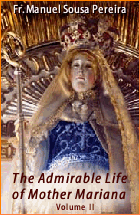
Dear Madam,
I am writing you from the Vendée in France where I teach History in college. I am a practicing Catholic and I am very interested in your translation of the book by Fray Manuel Sousa Pereira. This text is fascinating, but several questions come to mind, as a historian:
1. The Blessed Virgin speaks of the sect of Freemasons, while it did not exist in the 17th century. In the Spanish text, however, is Freemasonry mentioned?
2. I read online that the original text of Fray Manuel Sousa Pereira was gone, and they only had one copy, is it true?
3. Are there any older works, closer to the time of Mother Mariana de Jesus Torres, in the archives?
4. Would it be possible to create a website in France that could be the translation of your site Our Lady of Good Success?
Thank you for your attention,
In Christo Rege,
C.K.